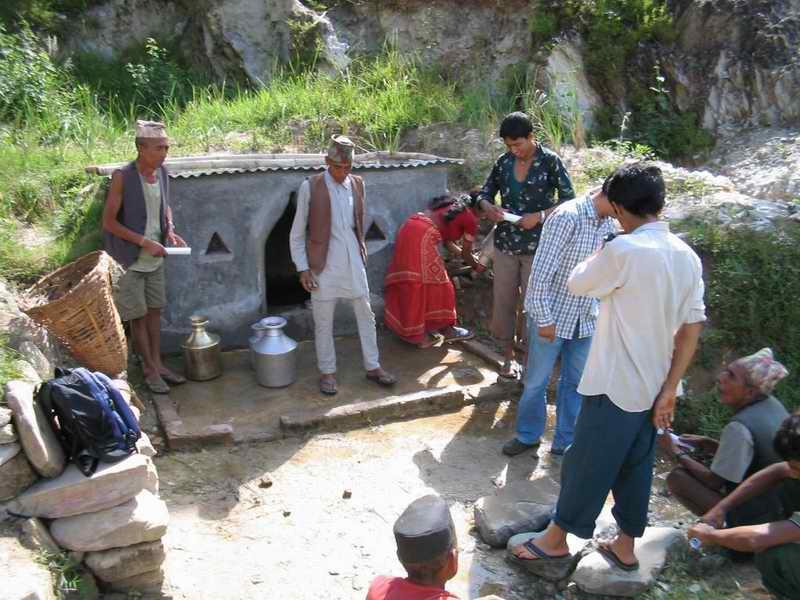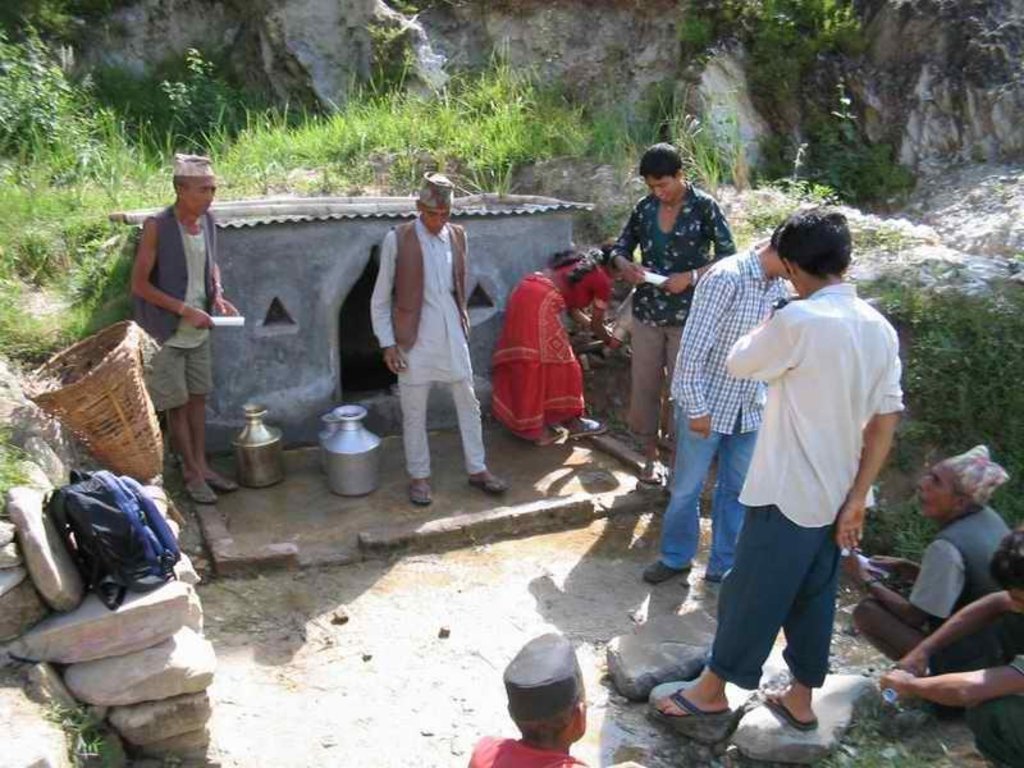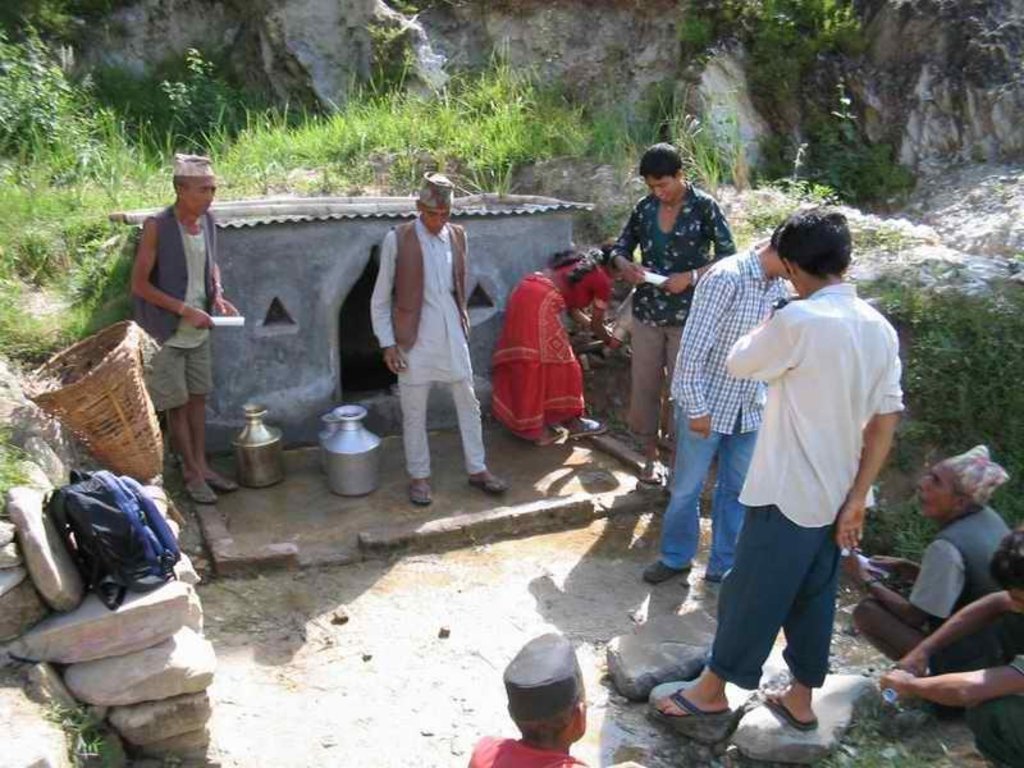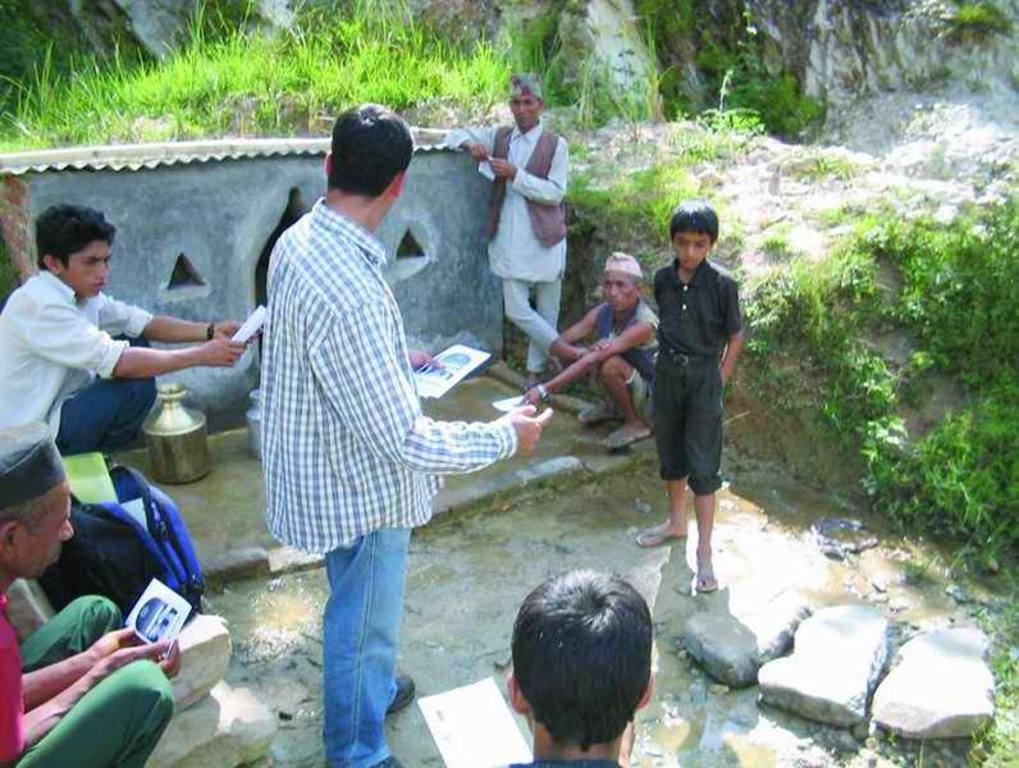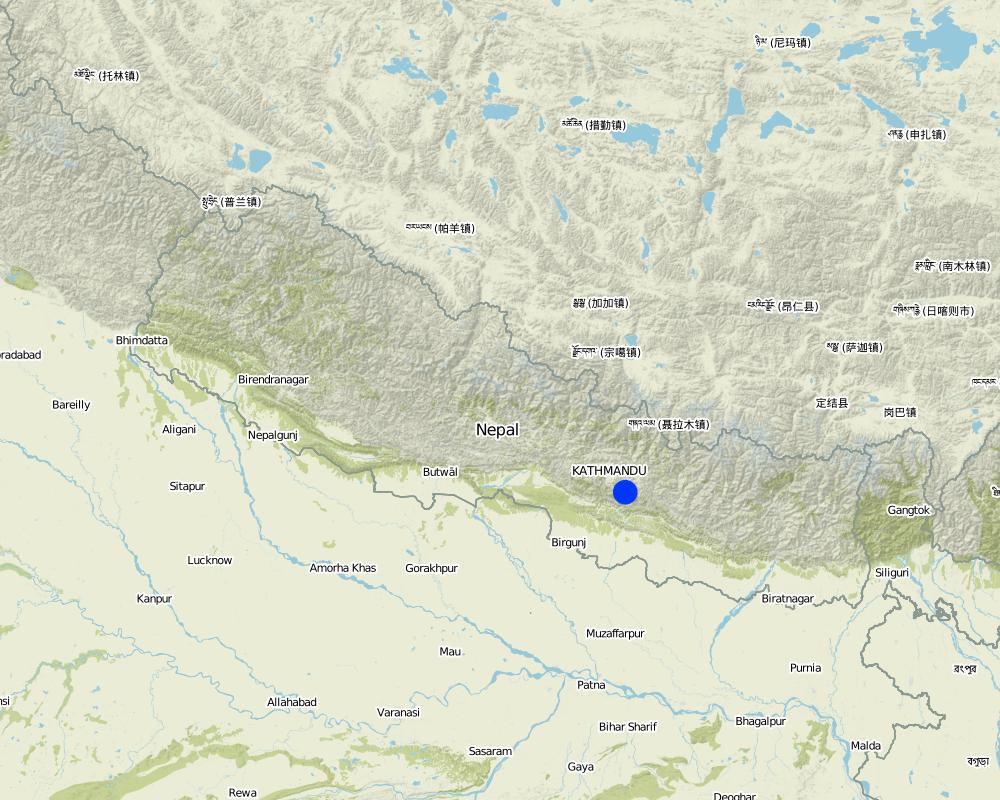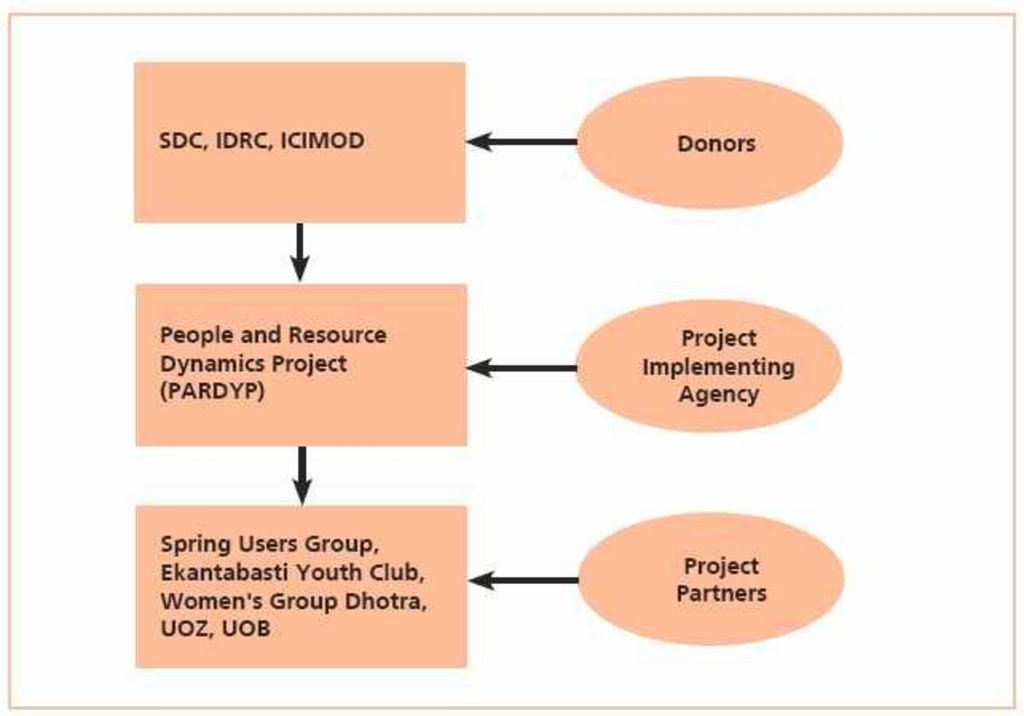Community efforts for improving drinking water quality [Nepal]
- Criação:
- Atualização:
- Compilador/a: Madhav Dhakal
- Editor: –
- Revisor: Fabian Ottiger
Piune paani ko gunastar sudhar ka lagi samudayik prayas
approaches_2352 - Nepal
Veja as seções
Expandir tudo Recolher tudo1. Informação geral
1.2 Detalhes do contato das pessoas capacitadas e instituições envolvidas na avaliação e documentação da abordagem
Especialista em GST:
Isabelle Provodoli
himcat@icimod.org
International Centre for Integrated Mountain Development (ICIMOD), GPO
Box. 3226, Kathmandu
Nepal
Nome da(s) instituição(ões) que facilitou(ram) a documentação/avaliação da Abordagem (se relevante)
CDE Centre for Development and Environment (CDE Centre for Development and Environment) - SuíçaNome da(s) instituição(ões) que facilitou(ram) a documentação/avaliação da Abordagem (se relevante)
ICIMOD International Centre for Integrated Mountain Development (ICIMOD) - Nepal1.3 Condições em relação ao uso da informação documentada através de WOCAT
O compilador e a(s) pessoa(s) capacitada(s) aceitam as condições relativas ao uso de dados documentados através do WOCAT:
Sim
1.4 Referência ao(s) questionário(s) sobre tecnologias da GST
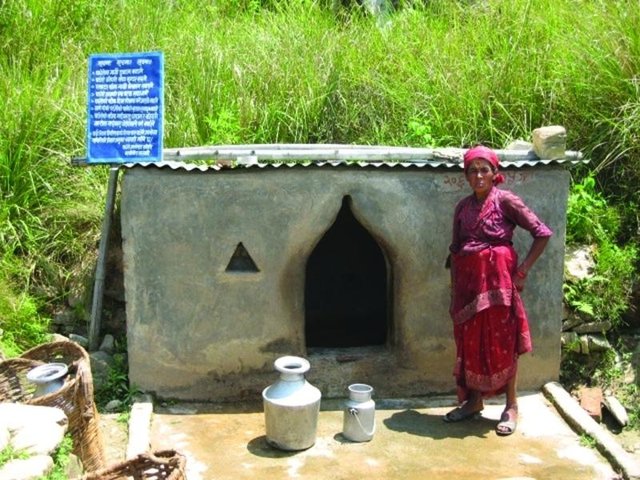
Drinking water quality improvement through conservation measures [Nepal]
Structural and vegetative measures to improve the quality of drinking water contaminated due to poor sanitation and seepage
- Compilador/a: Madhav Dhakal
2. Descrição da abordagem de GST
2.1 Descrição curta da abordagem
Working with communities to demonstrate and disseminate methods for improving drinking water quality using structural and vegetative measures
2.2 Descrição detalhada da abordagem
Descrição detalhada da abordagem:
Aims / objectives: The People and Resource Dynamics in Mountain Watersheds of the Hindu Kush- Himalayas Project (PARDYP) implemented this approach with 30 drinking water user households at Barbot in the Jhikhu Khola watershed, Kavre Palanchok. The aim was to improve water quality and availability from an open spring source through participatory planning and implementation. The approach first identified local concerns and observed the sanitary situation of the catchment area. Meetings were held jointly with men and women users from different caste groups (Brahmin, Chhetri, Newar and Kami) to discuss the problems and issues and to identify viable solutions. The advantages and disadvantages of the various options were discussed, after which users selected the following three measures to improve the drinking water supply: 1) building a brick-cement walled structure around the main local spring, 2) establishing check dams across nearby rills and gullies, and 3) planting grass around the spring box and tree saplings within the catchment area. The aim was to prevent direct flow of surface water into the spring and reduce contamination and turbidity of the source. Understanding and support was gained by demonstrating the technology and running an awareness campaign.
Role of stakeholders: The project helped form a users committee made up of 11 women and 1 man and encouraged them to plant grass and tree seedlings across the entire catchment. The project regularly measured the quality of the water and shared the results with the users. Rules and regulations were developed to ensure equitable access to the spring and its sustainable use and management. A notice board with do’s and don’ts was placed near the spring. The users held monthly meetings and established a revolving fund for maintaining the structures. Spring users followed the rules and regulations by washing, cleaning, and bathing at separate sources. Livestock grazing was stopped in the nearby area and the area was regularly cleaned. Furthermore, users were encouraged to treat water for drinking using simple methods like SODIS and the low cost Safa filter to avoid microbiological contamination. They were made more aware of water quality, sanitation, and health issues.
2.3 Fotos da abordagem
2.5 País/região/locais onde a abordagem foi aplicada
País:
Nepal
Especificação adicional de localização:
Kavrepalanchowk district/ Jhikhu Kholawatershed
Map
×2.6 Datas de início e término da abordagem
Ano de término (caso a abordagem não seja mais aplicada):
2005
2.7 Tipo de abordagem
- Baseado em projeto/programa
2.8 Principais metas/objetivos da abordagem
The Approach focused on SLM only
- To explore and demonstrate appropriate water quality improving technologies and methods in a participatory way. - To increase awareness on water quality, water treatment, and health and hygiene. - To share knowledge gained on the water improvement options with farmers and other stakeholders
The SLM Approach addressed the following problems: Weak institutional collaboration to develop technological options for improving drinking water quality and availability and to raise awareness on health and hygiene and waterborne diseases.
2.9 Condição que propiciam ou inibem a implementação de tecnologia/tecnologias aplicada(s) segundo a abordagem
Disponibilidade/acesso a recursos e serviços financeiros
- Inibitivo
For the maintenance of the implemented technology
Treatment through the SLM Approach: Revolving fund collected by users
Quadro institucional
- Inibitivo
Weak institutional collaboration
Treatment through the SLM Approach: User group formed linking local community organisations
Quadro jurídico (posse de terra, direitos de uso da terra e da água)
- Propício
The existing land ownership, land use rights / water rights greatly helped the approach implementation: mostly state owned land and some private land - which helped implementating the technology as there was no conflict.
Conhecimento sobre GST, acesso a suporte técnico
- Inibitivo
Different water treatment methods
Treatment through the SLM Approach: Awareness of structural and vegetative measures; direct water treatment methods including Safa filter, SODIS, chlorination
3. Participação e papel das partes interessadas envolvidas
3.1 Partes interessadas envolvidas na abordagem e seus papéis
- Usuários de terra/comunidades locais
Land users worked equally divided between men and women
Improvement of drinking water quality and quantity was the major concern of all spring users.
- Organização não governamental
- Governo nacional (planejadores, responsáveis pelas decisões)
- Organização internacional
PARDYP/ICIMOD
Caso várias partes interessadas foram envolvidas, indique a agência líder:
Concept designed by national specialist and implemented jointly with users
3.2 Envolvimento do usuários de terra/comunidades locais nas diferentes fases da abordagem
| Envolvimento do usuários de terra/comunidades locais | Especifique quem estava envolvido e descreva as atividades | |
|---|---|---|
| Iniciação/motivação | Participativo | public meetings; meetings organised to identify problems and possible options to overcome them. |
| Planejamento | Participativo | public meetings; organised regularly to identify implementing steps, and role and responsibility of different stakeholders in overcoming problems |
| Implementação | Participativo | responsibility for major steps; the user group responsible for implementation and the project for technical support |
| Monitoramento/avaliação | Participativo | The quality of the water was measured in each season to monitor the impact of the technology. Detailed progress reports, results, and lessons learned were shared with district level institutions and authorities, water quality reports were shared with spring users at public meetings |
| Research | Passivo | Water quality and availability recorded before and after technology implemented. Studies on access to water and confl icts among users |
3.3 Fluxograma (se disponível)
Descrição:
PARDP project donors and implementing partners-- SDC: Swiss Agency for Development and Cooperation IDRC: International Development Research Centre ICIMOD: International Centre for Integrated Mo
Autor:
Madhav Dhakal
3.4 Decisão sobre a seleção de tecnologia/tecnologias de GST
Especifique quem decidiu sobre a seleção de tecnologia/tecnologias a serem implementadas:
- Principalmente usuários da terra, apoiados por especialistas em GST
Explique:
Users selected three of the potential conservation options.
Decisions on the method of implementing the SLM Technology were made by mainly by land users supported by SLM specialists. The technology and associated measures were not new to the area and the implementing methods were simple and have been practised for a long time. The project initiated the formation of a users committee and the committee conducted the conservation activities.
4. Suporte técnico, reforço das capacidades e gestão do conhecimento
4.1 Reforço das capacidades/formação
Foi oferecida formação aos usuários da terra/outras partes interessadas?
Sim
Especifique quem foi capacitado:
- Usuários de terra
Tipo de formação:
- Reuniões públicas
Assuntos abordados:
Concept of conservation measures, and methods of treating contaminated water using SODIS and safa filter.
4.2 Serviço de consultoria
Os usuários de terra têm acesso a um serviço de consultoria?
Sim
Especifique se foi oferecido serviço de consultoria:
- nas áreas dos usuários da terra
Descreva/comentários:
Name of method used for advisory service: Sharing information on water quality status, and raising awareness among users.; Key elements: catchment conservation, health hygiene, water treatment methods; 1) Advisory service was carried out through: projects own extension structure and agents; Extension staff: specifically hired project employees 2) Target groups for extension: land users; Activities: awareness on health hygiene; catchment conservation activities and water treatment methods were shared during meetings.
Advisory service is quite adequate to ensure the continuation of land conservation activities
4.3 Fortalecimento da instituição (desenvolvimento organizacional)
As instituições foram fortalecidas ou estabelecidas através da abordagem?
- Sim, pouco
Especifique a que nível (níveis) as instituições foram fortalecidas ou estabelecidas:
- Local
Especifique o tipo de apoio:
- Reforço das capacidades/formação
Dê mais detalhes:
Training on water quality treatment provided to local club
4.4 Monitoramento e avaliação
Monitoramento e avaliação são partes da abordagem?
Sim
Comentários:
bio-physical aspects were ad hoc monitored through observations; indicators: land use and degradation, sanitary inspection, history of spring, available resources to trap water
technical aspects were regular monitored through measurements; indicators: seasonal water quality and discharge
socio-cultural aspects were ad hoc monitored through observations; indicators: number of spring users, household water requirements, users' issues
no. of land users involved aspects were regular monitored through measurements; indicators: participation in conservation activities
There were few changes in the Approach as a result of monitoring and evaluation: The project consulted with the local women's cooperative to solve a conflict over water quantity and access to spring source.
4.5 Pesquisa
A pesquisa foi parte da abordagem?
Sim
Especifique os tópicos:
- Sociologia
- Tecnologia
Dê mais detalhes e indique quem realizou a pesquisa:
Access to drinking water, conflicts at water fetching times, water quality and quantity measurement, and effectiveness of water treatment methods.
Research was carried out on station
5. Financiamento e apoio material externo
5.1 Orçamento anual para o componente de GST da abordagem
Caso o orçamento exato seja desconhecido, indique a faixa:
- < 2.000
Comentários (p. ex. principais fontes de recursos/principais doadores):
Approach costs were met by the following donors: international (SDC, IDRC, ICIMOD): 90.0%; local community / land user(s) (users group): 10.0%
5.3 Subsídios para entradas específicas (incluindo mão-de-obra)
- Outro
| Outros (especifique) | Em que medida | Especifique os subsídios |
|---|---|---|
| Planting materials |
Se a mão-de-obra pelos usuários da terra foi uma entrada substancial, isso foi:
- Voluntário
Comentários:
In implementing the technology and the approach
5.4 Crédito
Foi concedido crédito segundo a abordagem para atividades de GST?
Sim
6. Análise de impactos e declarações finais
6.1 Impactos da abordagem
A abordagem auxiliou os usuários da terra a implementar e manter as tecnologias de GST?
- Não
- Sim, pouco
- Sim, moderadamente
- Sim, significativamente
To build awareness on SLM and methods of improving drinking water quality. It also helped users to work in a group.
Did other land users / projects adopt the Approach?
- Não
- Sim, pouco
- Sim, moderadamente
- Sim, significativamente
Similar approaches are being followed in other communities across Nepal.
6.2 Principal motivação dos usuários da terra para implementar a GST
- Carga de trabalho reduzida
due to reduced water fetching time (or distance).
- Consciência ambiental
Improved heath due to clean water and better sanitation
6.3 Atividades de sustentabilidade de abordagem
Os usuários da terra podem manter o que foi implementado através da abordagem (sem apoio externo)?
- Sim
Caso afirmativo, descreva como:
Users are maintaining the implemented technology and also protecting the other nearby spring sources.
6.4 Pontos fortes/vantagens da abordagem
| Pontos fortes/vantagens/oportunidades na visão do usuário da terra |
|---|
| Water users committee formed, revolving fund collected, and rules and regulations developed for the sustainable management of the drinking water system (How to sustain/ enhance this strength: Maintain links with local community mobilisation groups for continuous guidance and support for the user group and for the proper use of the revolving fund.) |
| Pontos fortes/vantagens/oportunidades na visão do compilador ou de outra pessoa capacitada |
|---|
| Users have become more aware of sanitation issues than before (How to sustain/ enhance this strength: Awareness campaigns should be organized regularly covering more villages.) |
| Users have become more aware of 1) the quality of their drinking water, 2) its impact on their health, 3) water quality improvement options, and 4) the importance of soil and water conservation (How to sustain/ enhance this strength: Water quality testing campaigns should be continued and technical know how about different water quality treatment methods for improved health shared at regular meetings) |
6.5 Pontos fracos, desvantagens da tecnologia e formas de superá-los
| Pontos fracos/desvantagens/riscos na visão do usuário da terra | Como eles podem ser superados? |
|---|---|
| Water aviallability is still insufficient during dry period (March -May) | Other available nearrer sources should also be used, catchment protection activities should be continued. |
| Pontos fracos/vantagens/riscos na visão do compilador ou de outra pessoa capacitada | Como eles podem ser superados? |
|---|---|
| Conflicts are visible during the dry season due to insufficient quantity of water. | Good coordination among the group members should minimise conflicts- the strong and balanced role of users committee is vital for the equitable sharing of benefits. |
7. Referências e links
7.1 Métodos/fontes de informação
- visitas de campo, pesquisas de campo
- entrevistas com usuários de terras
7.2 Referências às publicações disponíveis
Título, autor, ano, ISBN:
ICIMOD (2007) Good Practices in Watershed Management, Lessons Learned in the Mid Hills of Nepal. Kathmandu: ICIMOD
Disponível de onde? Custos?
ICIMOD
Links e módulos
Expandir tudo Recolher tudoLinks

Drinking water quality improvement through conservation measures [Nepal]
Structural and vegetative measures to improve the quality of drinking water contaminated due to poor sanitation and seepage
- Compilador/a: Madhav Dhakal
Módulos
Não há módulos


